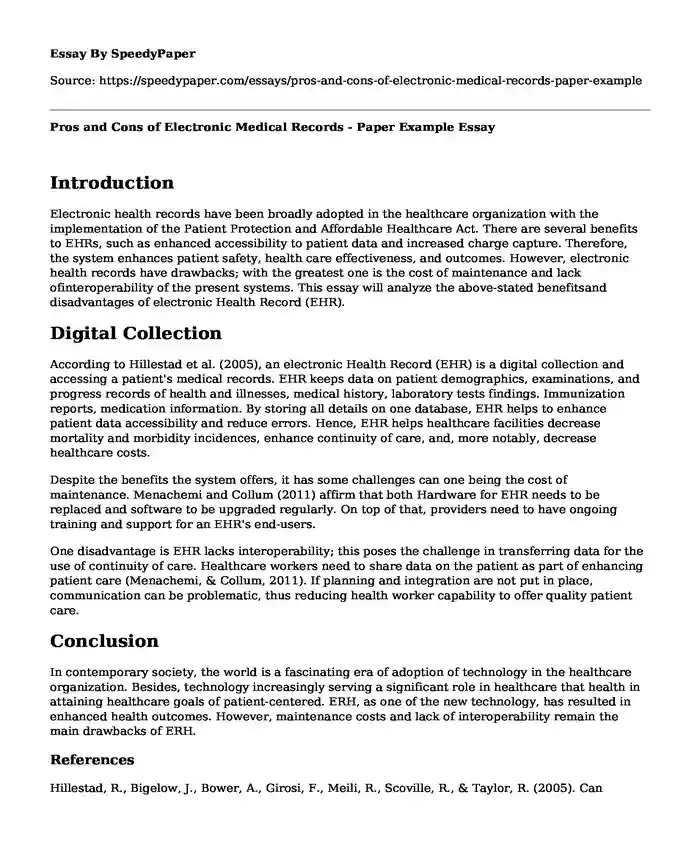
| Type of paper: | Essay |
| Categories: | Medicine Electronics |
| Pages: | 2 |
| Wordcount: | 407 words |
Introduction
Electronic health records have been broadly adopted in the healthcare organization with the implementation of the Patient Protection and Affordable Healthcare Act. There are several benefits to EHRs, such as enhanced accessibility to patient data and increased charge capture. Therefore, the system enhances patient safety, health care effectiveness, and outcomes. However, electronic health records have drawbacks; with the greatest one is the cost of maintenance and lack ofinteroperability of the present systems. This essay will analyze the above-stated benefitsand disadvantages of electronic Health Record (EHR).
Digital Collection
According to Hillestad et al. (2005), an electronic Health Record (EHR) is a digital collection and accessing a patient's medical records. EHR keeps data on patient demographics, examinations, and progress records of health and illnesses, medical history, laboratory tests findings. Immunization reports, medication information. By storing all details on one database, EHR helps to enhance patient data accessibility and reduce errors. Hence, EHR helps healthcare facilities decrease mortality and morbidity incidences, enhance continuity of care, and, more notably, decrease healthcare costs.
Despite the benefits the system offers, it has some challenges can one being the cost of maintenance. Menachemi and Collum (2011) affirm that both Hardware for EHR needs to be replaced and software to be upgraded regularly. On top of that, providers need to have ongoing training and support for an EHR's end-users.
One disadvantage is EHR lacks interoperability; this poses the challenge in transferring data for the use of continuity of care. Healthcare workers need to share data on the patient as part of enhancing patient care (Menachemi, & Collum, 2011). If planning and integration are not put in place, communication can be problematic, thus reducing health worker capability to offer quality patient care.
Conclusion
In contemporary society, the world is a fascinating era of adoption of technology in the healthcare organization. Besides, technology increasingly serving a significant role in healthcare that health in attaining healthcare goals of patient-centered. ERH, as one of the new technology, has resulted in enhanced health outcomes. However, maintenance costs and lack of interoperability remain the main drawbacks of ERH.
References
Hillestad, R., Bigelow, J., Bower, A., Girosi, F., Meili, R., Scoville, R., & Taylor, R. (2005). Can electronic medical record systems transform health care? Potential health benefits, savings, and costs. Health Affairs, 24(5), 1103-1117. https://www.healthaffairs.org/doi/abs/10.1377/hlthaff.24.5.1103
Menachemi, N., & Collum, T. H. (2011). Benefits and drawbacks of electronic health record systems. Risk management and healthcare policy, 4, 47. 10.2147/RMHP.S12985.
Cite this page
Pros and Cons of Electronic Medical Records - Paper Example. (2023, Dec 12). Retrieved from https://speedypaper.net/essays/pros-and-cons-of-electronic-medical-records-paper-example
Request Removal
If you are the original author of this essay and no longer wish to have it published on the SpeedyPaper website, please click below to request its removal:
- Health Concepts in the Definition Essay Example
- Free Essay with a Personal Diabetic Meal Plan
- Essay Sample Claiming that Abortion Should Not Be Illegal in the United States
- Essay Sample on Building Online Credibility
- Essay Sample: Customer Service
- Essay Sample on Decontamination Principles
- Paper Example on Dystopian Short Story: Technology and Social Issues
Popular categories




